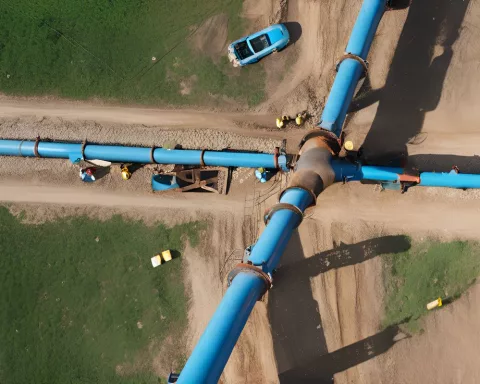The Gauteng Department of Health in South Africa is using innovative technologies to improve emergency medical services. They have implemented push-to-talk devices and cameras in emergency vehicles to improve response times and protect against paramedic attacks. The department also collaborates with law enforcement agencies and has acquired specialized 4×4 ambulances to access all terrains in the province. Despite challenges like service delivery protests and hot zones, the EMS system is making significant progress toward enhancing efficiency and ensuring public safety.
How is Gauteng Health improving emergency medical services?
The Gauteng Department of Health has implemented innovative technologies like push-to-talk devices and cameras in emergency vehicles to improve response times and protect against paramedic attacks. The department also collaborates with law enforcement agencies and has acquired specialized 4×4 ambulances to access all terrains in the province. Furthermore, the Gauteng Scheduled Emergency Transport program decreases patient wait times during referrals between healthcare facilities. Despite challenges like service delivery protests and hot zones, the EMS system is making significant progress toward enhancing efficiency and ensuring public safety.
Tackling Emergency Medical Services Challenges in Gauteng
The Emergency Medical Services (EMS) in Gauteng, South Africa, must contend with a rapidly growing population and a surge of emergency calls. Nevertheless, the service has been able to achieve an 88% response rate for calls within the “golden hour,” which is under 60 minutes. This accomplishment surpasses the international standard of 80%. MEC for Health and Wellness Nomantu Nkomo-Ralehoko recently discussed this information while answering questions in the Gauteng Provincial Legislature.
The goal for priority 1 response times, which involve life-threatening situations, is to be under 30 minutes in urban areas and 60 minutes in rural areas. Currently, EMS responds to approximately 70,000 emergencies per month, with 3% of them being priority 1 cases. Of these priority 1 cases, 1% are medical cases, while 2% are trauma cases that require law enforcement intervention.
Innovative Technologies and Collaborative Efforts to Improve EMS
To enhance response times and the overall effectiveness of EMS, the Gauteng Department of Health (GDoH) has invested in innovative technologies. These include push-to-talk devices with live tracking for emergency calls, panic buttons, and cameras installed in emergency vehicles. These measures help protect against paramedic attacks, which can lead to delayed responses. Additionally, the department collaborates with law enforcement agencies such as SAPS, Metro Police, and Gauteng Crime Prevention Wardens to offer escorts in high-risk areas.
Nkomo-Ralehoko also emphasized the acquisition of five specialized 4×4 ambulances to access all terrains in the province. Moreover, the department launched the Gauteng Scheduled Emergency Transport (G-SET), which aims to decrease patient wait times during referrals between healthcare facilities. With the introduction of G-SET, more ambulances will be available to respond to primary calls, including accidents, assaults, and home emergencies. The program has already demonstrated positive results regarding response times, patient referral and transportation models, and overall patient experience.
Overcoming Obstacles and Ensuring Public Safety
However, the MEC noted that service delivery protests, hot zones (areas where ambulances need police escorts), and paramedic attacks still significantly contribute to delays in response times. The GDoH continues to encourage the public not to hinder ambulances during protests and to prevent criminals from intimidating EMS crews from performing their duties.
As Gauteng EMS confronts these challenges, the utilization of innovative technologies and partnerships with law enforcement agencies is instrumental in improving response times. With the implementation of G-SET and specialized vehicles, the department is making substantial progress toward enhancing the efficiency of emergency medical services in the province. Consequently, the residents of Gauteng can anticipate a more dependable and efficient EMS system, guaranteeing their safety and well-being during emergencies.
Setting an Example for Global EMS Providers
By embracing these groundbreaking solutions and strategies, Gauteng EMS serves as an outstanding model for other emergency medical service providers worldwide. As the demand for emergency medical services continues to expand, it is crucial to invest in state-of-the-art technology and collaborative efforts to deliver timely, effective care to those in need. The success of Gauteng EMS in maintaining and improving response times, even amidst escalating challenges, illustrates the potential for other organizations to achieve comparable results.
1. What is the Gauteng Department of Health doing to improve emergency medical services?
The Gauteng Department of Health has implemented innovative technologies like push-to-talk devices and cameras in emergency vehicles and has acquired specialized 4×4 ambulances to access all terrains in the province. The department also collaborates with law enforcement agencies to offer escorts in high-risk areas.
2. What is the response rate for calls within the “golden hour” in Gauteng?
The EMS in Gauteng has achieved an 88% response rate for calls within the “golden hour,” which is under 60 minutes, surpassing the international standard of 80%.
3. What is the goal for priority 1 response times in Gauteng?
The goal for priority 1 response times, which involve life-threatening situations, is to be under 30 minutes in urban areas and 60 minutes in rural areas.
4. How many emergencies does EMS respond to in Gauteng per month?
EMS responds to approximately 70,000 emergencies per month in Gauteng.
5. What percentage of the emergencies in Gauteng are priority 1 cases?
3% of the emergencies in Gauteng are priority 1 cases, with 1% being medical cases and 2% being trauma cases that require law enforcement intervention.
6. What innovative technologies has the Gauteng Department of Health invested in to improve EMS?
The Gauteng Department of Health has invested in push-to-talk devices with live tracking for emergency calls, panic buttons, and cameras installed in emergency vehicles to improve response times and protect against paramedic attacks.
7. What specialized vehicles has the Gauteng Department of Health acquired to improve EMS?
The Gauteng Department of Health has acquired five specialized 4×4 ambulances to access all terrains in the province.
8. What challenges does Gauteng EMS face in improving response times?
Gauteng EMS faces challenges such as service delivery protests, hot zones, and paramedic attacks, which significantly contribute to delays in response times. The department continues to encourage the public not to hinder ambulances during protests and to prevent criminals from intimidating EMS crews from performing their duties.








